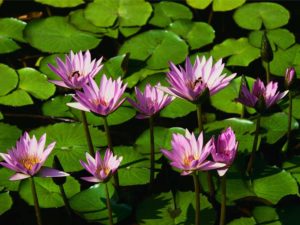All Articles, Pond Life
Plants For Your Pond
Water plants help to create a natural ecosystem within your pond. They will provide shade and shelter for fish as well as help to filter and oxygenate the water. Water plants can help to provide a habitat to bring frogs into the garden as well as create a beautiful display of colours and textures.
There are many types of water plants that will thrive in Western Australia’s climate, including many Australian natives such as reeds, sedges, water fringe and water ribbon.

Water lilies are one of the most popular water plants, providing a stunning array of brightly coloured flowers through spring and summer. Their large flat leaves shade and shelter the fish below. Water lilies prefer a full-sun position with a minimum depth of 400mm if grown in pots. They will not tolerate water splashing on their leaves, so they must be positioned in a still part of the pond.
Water irises are another popular pond plant, the Louisianna Iris will grow with its roots submerged in water all year round in a sunny position and will flower prolifically through spring. Many colours are available. Fully submerged plants such as Vallisneria or "ribbon grass" will help to oxygenate the water as oxygen is produced by the plant as a by-product of photosynthesis. Tiny air bubbles can often be seen on the submerged leaves on a sunny day. They can grow in shallow or deeper water, in sun or part shade.
Reeds, sedges and grasses are ideal for frog ponds. There are many native species and frogs and fish will lay their eggs among the stems. Reeds are also good as a taller pond plant, they can tolerate windy sites better than those with broad or flat leaves. Most reeds and sedges will produce interesting seed heads as opposed to flowers. They prefer a sunny position in shallow water or boggy areas. Low growing plants such as Bacopa and Ludwigia are an excellent choice for trailing over rocks and cascades. They can also be used in floating rings which can move about on the pond surface to shelter and shade below. Many of the low spreading water plants will flower profusely during the warm seasons. Most will grow in sun or shade, but will flower more in sun.
There are also some edible plants, water cress, water parsley and water chestnuts. These are easy to grow and can be harvested to eat.
In most garden ponds it is best to leave your water plants in pots. The pots can be submerged in the pond to the correct depth for each different type, and the soil will be contained within the pot where the plant can draw its nutrients without polluting the rest of the pond. A layer of river sand then gravel stones on the top of the pots will help to keep the soil from directly contacting the water, the stones will stop the fish from digging around in the soil. An aquatic potting mix should be used in the pots, or a mild soil without too much nutrient content. Excess nutrient may encourage algae growth. Aquatic fertiliser tablets can be used to provide slow release feeding through the warm seasons. The tablets can be pushed into the pots near the roots to feed the plant without polluting the water. Liquid aquatic plant fertilisers can also be used with care, Never use any fertilisers that are not specifically for aquatic plants! Because they are always in water, pond plants tend to grow vigorously and can often get out of control and take over a pond. This is another good reason to keep them in pots, as you can lift them out once or twice a year to trim, divide and re-pot any that have grown too large.
Most pond plants will do well in a wide range of water conditions, one factor which can restrict their growth is the pH of the water. The ideal pH for most pond plants is between 6.5 and 7.5. A pH Test kit can be used to check your pond water and if needed products are available to raise or lower the pH level as required.
